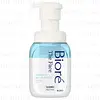What's inside
What's inside
 Key Ingredients
Key Ingredients

No key ingredients
 Benefits
Benefits

 Concerns
Concerns

 Ingredients Side-by-side
Ingredients Side-by-side

Water
Skin ConditioningPropylene Glycol
HumectantPEG-150
HumectantGlycerin
HumectantLauric Acid
CleansingLaureth-6 Carboxylic Acid
CleansingMyristic Acid
CleansingArginine
MaskingLauryl Hydroxysultaine
CleansingPotassium Hydroxide
BufferingDecyl Glucoside
CleansingLaureth-4 Carboxylic Acid
Palmitic Acid
EmollientPolyquaternium-39
Acrylates Copolymer
Ethylhexylglycerin
Skin ConditioningDisodium EDTA
Phenoxyethanol
PreservativeParfum
MaskingWater, Propylene Glycol, PEG-150, Glycerin, Lauric Acid, Laureth-6 Carboxylic Acid, Myristic Acid, Arginine, Lauryl Hydroxysultaine, Potassium Hydroxide, Decyl Glucoside, Laureth-4 Carboxylic Acid, Palmitic Acid, Polyquaternium-39, Acrylates Copolymer, Ethylhexylglycerin, Disodium EDTA, Phenoxyethanol, Parfum
Ingredients Explained
These ingredients are found in both products.
Ingredients higher up in an ingredient list are typically present in a larger amount.
Lauric Acid is a fatty acid or lipid. About half of fatty acids in coconut oil is lauric acid.
This ingredient helps hydrate and sooth skin. As a humectant, it helps trap moisture. It also aids in cleaning and enhancing the texture of products.
Lauric acid may not be Malassezia folliculitis, or fungal acne, safe.
Learn more about Lauric AcidWe don't have a description for Lauryl Hydroxysultaine yet.
Water. It's the most common cosmetic ingredient of all. You'll usually see it at the top of ingredient lists, meaning that it makes up the largest part of the product.
So why is it so popular? Water most often acts as a solvent - this means that it helps dissolve other ingredients into the formulation.
You'll also recognize water as that liquid we all need to stay alive. If you see this, drink a glass of water. Stay hydrated!
Learn more about Water